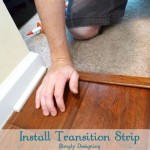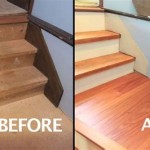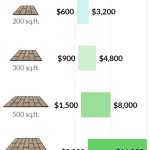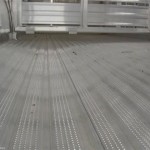Dark Bamboo Solid Wood Flooring: A Comprehensive Guide
Dark bamboo solid wood flooring has emerged as a popular alternative to traditional hardwood flooring, offering a distinctive aesthetic, durable surface, and sustainable sourcing. This article provides a detailed overview of dark bamboo solid wood flooring, covering its properties, manufacturing process, advantages, disadvantages, installation, maintenance, and suitability for various applications.
Bamboo, a rapidly renewable resource, is a type of grass that matures far quicker than hardwood trees. This rapid growth cycle contributes to bamboo flooring's reputation as an environmentally friendly option. When properly processed and manufactured, bamboo can be transformed into a solid and stable flooring material with a unique visual appeal.
Dark bamboo flooring obtains its color through a carbonization process. Carbonization involves heating the bamboo strips to high temperatures, which alters the sugar content within the bamboo, resulting in a darker, richer color. The degree of carbonization dictates the final shade of the flooring, ranging from light amber to deep, dark brown, often resembling exotic hardwoods.
The Manufacturing Process of Dark Bamboo Solid Wood Flooring
The production of dark bamboo solid wood flooring is a multi-stage process that transforms raw bamboo stalks into a finished flooring product. The process generally involves the following steps:
Harvesting and Selection: Mature bamboo culms (stalks) are harvested from sustainably managed bamboo forests. These culms are typically 4-6 years old, possessing the optimal density and maturity for flooring production. Careful selection ensures that only healthy and structurally sound bamboo is used.
Slicing and Stripping: The harvested culms are sliced into long, narrow strips. The outer skin of the bamboo, which is harder and less desirable, is often removed. These strips are then sorted and graded based on color, quality, and dimensions.
Carbonization: The bamboo strips undergo a carbonization process to achieve the desired dark color. The strips are placed in a heated chamber and exposed to high temperatures. The controlled heating process breaks down the sugars in the bamboo, resulting in a darkening effect. The intensity of the heat and the duration of the process influence the final color of the flooring.
Drying: After carbonization, the bamboo strips are carefully dried to reduce their moisture content. This is a critical step to prevent warping, shrinking, or cracking after installation. Kiln drying is a common method used to ensure uniform moisture removal.
Gluing and Pressing: The dried bamboo strips are coated with a strong adhesive and then pressed together under high pressure. This process creates a solid and stable plank of bamboo flooring. Different pressing configurations can result in different grain patterns, such as horizontal, vertical, or strand-woven.
Profiling and Milling: The pressed bamboo planks are then profiled and milled to create the tongue-and-groove edges that allow for interlocking installation. Precision milling is essential for a seamless and professional-looking floor.
Finishing: The final step involves applying a protective finish to the surface of the flooring. This finish enhances the durability, scratch resistance, and water resistance of the bamboo. Multiple coats of a polyurethane or acrylic finish are often applied to create a durable and long-lasting surface.
Quality Control: Throughout the manufacturing process, rigorous quality control checks are performed to ensure that the flooring meets the required standards for dimensions, moisture content, finish quality, and overall structural integrity.
Advantages of Dark Bamboo Solid Wood Flooring
Dark bamboo solid wood flooring offers several advantages that make it a compelling flooring option for homeowners and designers alike:
Aesthetic Appeal: The dark, rich color of carbonized bamboo flooring provides a sophisticated and elegant look. It complements a wide range of interior design styles, from modern and contemporary to traditional and rustic. The unique grain pattern of bamboo adds visual interest and character to any room.
Durability: Solid bamboo flooring is a dense and durable material that can withstand everyday wear and tear. It is resistant to scratches, dents, and stains, making it suitable for high-traffic areas. The hardness of bamboo is comparable to many hardwood species, ensuring a long-lasting flooring surface.
Sustainability: As a rapidly renewable resource, bamboo is a more sustainable alternative to traditional hardwoods. Bamboo matures in just a few years, compared to the decades required for hardwood trees to grow. This rapid growth cycle reduces the pressure on forests and contributes to a more environmentally responsible building practice.
Dimensional Stability: Properly manufactured solid bamboo flooring exhibits good dimensional stability, meaning it is less likely to expand or contract due to changes in humidity. This stability is crucial for preventing gaps or buckling in the flooring after installation.
Ease of Maintenance: Dark bamboo flooring is relatively easy to maintain. Regular sweeping or vacuuming and occasional damp mopping are typically sufficient to keep the floor clean and looking its best. Avoid using harsh chemicals or abrasive cleaners, as these can damage the finish.
Cost-Effectiveness: In many cases, dark bamboo flooring can be more cost-effective than some types of exotic hardwood flooring. This makes it an attractive option for homeowners seeking a stylish and durable flooring solution without breaking the bank.
Disadvantages of Dark Bamboo Solid Wood Flooring
While dark bamboo solid wood flooring offers numerous advantages, it is important to be aware of potential drawbacks:
Susceptibility to Moisture: Like all wood flooring products, bamboo is susceptible to moisture damage. Excessive moisture can cause warping, swelling, or even mold growth. It is crucial to protect bamboo flooring from prolonged exposure to water or high humidity. It is not recommended for bathrooms or laundry rooms without proper ventilation and precautions.
Color Fading: Over time, prolonged exposure to sunlight can cause the dark color of carbonized bamboo flooring to fade. This is a natural process that affects most wood flooring products. Using window coverings or applying a UV-resistant finish can help to minimize fading.
Scratch Visibility: While bamboo flooring is generally scratch-resistant, dark finishes tend to show scratches more readily than lighter finishes. This is because scratches expose the lighter-colored bamboo underneath the dark finish. Regular maintenance and the use of floor protectors can help to prevent scratches.
Variability in Quality: The quality of bamboo flooring can vary depending on the manufacturer and the manufacturing process. It is important to choose flooring from reputable manufacturers who adhere to strict quality control standards. Lower-quality bamboo flooring may be less durable and more prone to problems.
Formaldehyde Concerns: Some bamboo flooring products may contain formaldehyde, a volatile organic compound (VOC) that can off-gas into the air. It is essential to choose bamboo flooring that is certified to meet low-VOC standards, such as those established by the California Air Resources Board (CARB) or the Forest Stewardship Council (FSC).
Repair Challenges: While bamboo flooring is durable, it can be challenging to repair if it is damaged. Matching the color and grain pattern of replacement planks can be difficult, especially if the original flooring has faded over time. Professional repair services may be required.
Potential for Indentation: While hard, bamboo can be indented by heavy objects or sharp impacts. Using furniture pads under the legs of heavy furniture and avoiding dropping heavy objects on the floor can help prevent indentations.
Not Ideal for All Subfloors: Solid bamboo flooring typically requires a level and stable subfloor. Variations in subfloor height or instability can lead to problems with the flooring after installation. Proper subfloor preparation is essential for a successful installation.
Limited Availability Compared to Hardwood: While bamboo flooring is becoming increasingly popular, it may not be as widely available as traditional hardwood flooring in some regions. This can make it more challenging to find the exact color and style you are looking for.
It is crucial to carefully weigh these advantages and disadvantages before deciding whether dark bamboo solid wood flooring is the right choice for a particular project.
Proper installation is critical to the performance and longevity of dark bamboo solid wood flooring. The installation process typically involves the following steps:
Subfloor Preparation: The subfloor must be clean, dry, level, and structurally sound. Any imperfections or irregularities in the subfloor should be addressed before installation begins. This may involve patching cracks, sanding down high spots, or reinforcing weak areas.
Acclimation: The bamboo flooring should be acclimated to the room's temperature and humidity levels for several days before installation. This allows the flooring to adjust to the environment and minimizes the risk of expansion or contraction after installation.
Moisture Barrier: A moisture barrier should be installed over the subfloor to protect the bamboo flooring from moisture migration. This barrier can be a plastic sheet or a specialized underlayment with a built-in moisture barrier.
Installation Method: Solid bamboo flooring can be installed using several methods, including nail-down, glue-down, or floating. The best installation method will depend on the subfloor type, the room's dimensions, and the installer's preferences. Nail-down installation is typically used over wooden subfloors, while glue-down installation is suitable for concrete subfloors. Floating installation involves interlocking the planks together without attaching them to the subfloor.
Expansion Gaps: Expansion gaps should be left around the perimeter of the room and around any fixed objects, such as pipes or columns. These gaps allow the flooring to expand and contract without putting pressure on the walls or other structures.
Finishing Touches: After the flooring is installed, baseboards and trim should be installed to cover the expansion gaps and create a finished look.

Bamboo Floor Porcelanico Madera Pisos Suelos De

Hydri Hdpc Sample Lexington Bamboo Engineered Handsc Waterproof Hardwood Flooring In The Samples Department At Com

Buy Solid Dark Bamboo Wood Flooring Bkb Uae Floorsdubai Com

Cali Bamboo Sample Fossilized Bordeaux Solid Distressed Waterproof Hardwood Flooring At Com

Dark Coffee Uniclic Bamboo Flooring 1850mm Simply

Goodhome Chaiya Dark Bamboo Wood Effect Real Top Layer Flooring 1 67m² Diy At B Q

Diy Solid Bamboo Wood Flooring Happihomemade Family Friendly Recipes

Dark Bamboo Flooring The Company

Pin By Sarah Solis On For Madison Hill House Dark Bamboo Flooring Design

Home Decorators Collection Java 3 8 In T X 5 1 W Strand Woven Engineered Bamboo Flooring 25 Sqft Case Hd13007a The Depot
Related Posts








